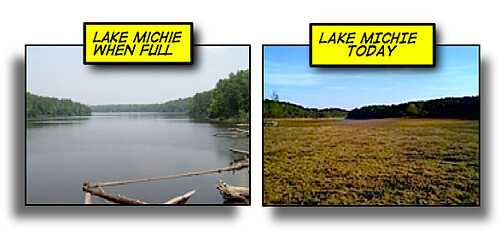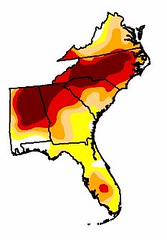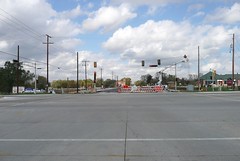Sprawl and the Southeastern drought

Posted February 8, 2008 at 4:34PM

You wouldn’t necessarily know it unless you live there, but the Southeastern US is undergoing a major drought right now. It seems to be at its worst in my “birth state” of North Carolina, which for months has been classified as in “exceptional” dryness, the worst of several drought intensity categories developed by a partnership of the US Department of Agriculture, National Weather Service, and others.
 The categories are based on some complicated science that I don’t quite understand, but precipitation and heat are certainly part of it, and “exceptional” is actually worse than “severe” and “extreme.” The US Drought Monitor says “exceptional” is characterized by “exceptional and widespread crop/pasture losses; shortages of water in reservoirs, streams, and wells creating water emergencies.” Anyone living in the darkest areas on the map of the Southeastern US to your left can tell you those aren’t good things. My friend in Durham (Go Blue Devils!) reports that, among other things, her family is now using buckets to collect shower and kitchen water while waiting for the water to warm up, and then using the collected water for toilet flushes. She wants to get a rain barrel, but rain barrels in her region are mostly sold out because of citizens’ efforts to cope with what they know to be necessary water use restrictions.
The categories are based on some complicated science that I don’t quite understand, but precipitation and heat are certainly part of it, and “exceptional” is actually worse than “severe” and “extreme.” The US Drought Monitor says “exceptional” is characterized by “exceptional and widespread crop/pasture losses; shortages of water in reservoirs, streams, and wells creating water emergencies.” Anyone living in the darkest areas on the map of the Southeastern US to your left can tell you those aren’t good things. My friend in Durham (Go Blue Devils!) reports that, among other things, her family is now using buckets to collect shower and kitchen water while waiting for the water to warm up, and then using the collected water for toilet flushes. She wants to get a rain barrel, but rain barrels in her region are mostly sold out because of citizens’ efforts to cope with what they know to be necessary water use restrictions.
Three of four major North Carolina reservoirs being tracked by the Charlotte News & Observer are seriously low as of the end of last month, with one of them now only at 18% of full. In Georgia, swimming pools may not be able to operate this summer, which, if you’ve lived in Georgia – and I have – is a brutal consequence. Even Coca-Cola’s syrup-making processes are being affected. All sorts of sobering information about drought conditions nationwide is collected and updated daily on the official US Drought Portal.
 Generally lost in the discourse about conservation measures and other steps to ease or prevent future drought is the role that sprawl – by spreading pavement around watersheds – plays in sending billions of gallons of rainwater into streams and rivers as polluted runoff, rather than into the soil to replenish groundwater. According to a 2002 report co-authored by my NRDC colleague Deron Lovaas, recent sprawl development around Atlanta sends an additional 57 billion to 133 billion gallons of polluted runoff into streams and rivers each year. This water would have otherwise filtered through the soil to recharge aquifers and provide underground flows to rivers, streams and lakes.
Generally lost in the discourse about conservation measures and other steps to ease or prevent future drought is the role that sprawl – by spreading pavement around watersheds – plays in sending billions of gallons of rainwater into streams and rivers as polluted runoff, rather than into the soil to replenish groundwater. According to a 2002 report co-authored by my NRDC colleague Deron Lovaas, recent sprawl development around Atlanta sends an additional 57 billion to 133 billion gallons of polluted runoff into streams and rivers each year. This water would have otherwise filtered through the soil to recharge aquifers and provide underground flows to rivers, streams and lakes.
I was on a conference panel yesterday with Lynn Richards, a stormwater expert at the US Environmental Protection Agency (and, BTW, a dynamic and articulate speaker). Lynn’s research demonstrates that smart growth helps. In particular, more compact growth patterns with an average of eight houses per acre reduce runoff per house by 74% compared to sprawling patterns of one house per acre. This is because, for a given amount of development, smart growth covers less of the watershed with pavement, particularly the road and street network required to serve the houses.
I wouldn’t argue that sprawl causes drought (although my colleagues in NRDC’s climate center could make a case that global warming does), or that smart growth cures it. But sprawl can indeed exacerbate its effects. And smart growth needs to be part of the long-range solution.
Many thanks to Merry Rabb for pointing me to numerous sources for this posting.